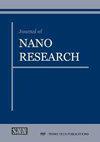Iron Oxide Nanoparticles Produced by a Low-Energy Nd: YAG Laser Ablation Technique and Their Application as Contrast Agent for Magnetic Resonance Imaging
IF 1
4区 材料科学
Q4 MATERIALS SCIENCE, MULTIDISCIPLINARY
引用次数: 0
Abstract
A magnetic resonance imaging contrast agent is proposed using iron oxide nanoparticles (IONPs) synthesized by a pulsed laser ablation technique. Experimentally, an Nd: YAG laser (1064 nm, 7 ns, 30 mJ) was directed and focused on a high-purity iron plate immersed in a liquid solution of deionized water and polyvinylpyrrolidone (PVP). After a few minutes of laser bombardment, iron oxide nanoparticles dispersed in the liquid were homogeneously produced. A reddish yellow color-colloidal IONPs are produced in the water, while its color changes to dark brown for the PVP solution. The characterization results demonstrated that IONPs in the form of Fe2O3 and Fe3O4 made in the PVP have an excellent dispersibility with a spherical shape that is significantly smaller than that of IONPs made in the deionized water at the same laser repetition rate. The produced IONPs are further applied as a contrast agent for the magnetic resonance imaging (MRI) modality by varying concentrations from 0.05 mM to 2.31 mM. The results demonstrated that images of the IONPs sample with a concentration of 2.31 mM showed the highest contrast enhancement (Cenh), with an enhancement factor of 221.875 % for T1-weighted images and 91.227 % for T2-weighted images. IONPs with a concentration of 2.31 mM had the highest signal-to-noise ratio (SNR) for a T1-weighted picture of 52.92, while IONPs with a concentration of 0.05 mM had the highest SNR for a T2-weighted image of 179.117.低能量Nd: YAG激光烧蚀法制备氧化铁纳米颗粒及其在磁共振成像造影剂中的应用
采用脉冲激光烧蚀技术合成氧化铁纳米颗粒(IONPs)作为磁共振成像造影剂。实验中,将Nd: YAG激光(1064 nm, 7 ns, 30 mJ)对准浸在去离子水和聚乙烯吡罗烷酮(PVP)溶液中的高纯度铁板。经过几分钟的激光轰击,分散在液体中的氧化铁纳米颗粒均匀产生。一种红黄色的胶体离子在水中产生,而PVP溶液的颜色则变成深棕色。表征结果表明,在PVP中制备的Fe2O3和Fe3O4形式的离子粒子具有优异的分散性,其球形结构明显小于在相同激光重复率下在去离子水中制备的离子粒子。生成的IONPs进一步用作磁共振成像(MRI)模式的造影剂,浓度从0.05 mM到2.31 mM不等。结果表明,浓度为2.31 mM的IONPs样品的图像显示出最高的对比度增强(Cenh), t1加权图像的增强因子为221.875%,t2加权图像的增强因子为91.227%。浓度为2.31 mM的IONPs在t1加权图像上的信噪比最高,为52.92;浓度为0.05 mM的IONPs在t2加权图像上的信噪比最高,为179.117。
本文章由计算机程序翻译,如有差异,请以英文原文为准。
求助全文
约1分钟内获得全文
求助全文
来源期刊

Journal of Nano Research
工程技术-材料科学:综合
CiteScore
2.40
自引率
5.90%
发文量
55
审稿时长
4 months
期刊介绍:
"Journal of Nano Research" (JNanoR) is a multidisciplinary journal, which publishes high quality scientific and engineering papers on all aspects of research in the area of nanoscience and nanotechnologies and wide practical application of achieved results.
"Journal of Nano Research" is one of the largest periodicals in the field of nanoscience and nanotechnologies. All papers are peer-reviewed and edited.
Authors retain the right to publish an extended and significantly updated version in another periodical.
 求助内容:
求助内容: 应助结果提醒方式:
应助结果提醒方式:


